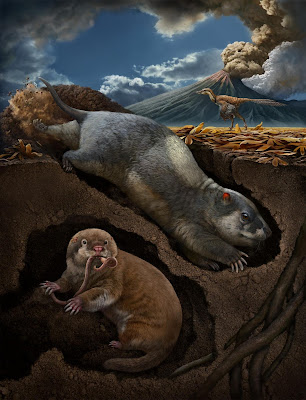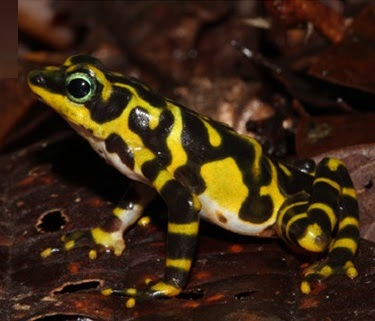[Most Recent Entries] [Calendar View]
Friday, April 9th, 2021
| Time | Event | ||||||
| 7:14a | [PaleoMammalogy • 2021] Fossiomanus sinensis & Jueconodon cheni • Fossoriality and Evolutionary Development in Two Cretaceous Mammaliamorphs
Abstract Mammaliamorpha comprises the last common ancestor of Tritylodontidae and Mammalia plus all its descendants. Tritylodontids are nonmammaliaform herbivorous cynodonts that originated in the Late Triassic epoch, diversified in the Jurassic period and survived into the Early Cretaceous epoch. Eutriconodontans have generally been considered to be an extinct mammalian group, although different views exist. Here we report a newly discovered tritylodontid and eutriconodontan from the Early Cretaceous Jehol Biota of China. Eutriconodontans are common in this biota, but it was not previously known to contain tritylodontids. The two distantly related species show convergent features that are adapted for fossorial life, and are the first ‘scratch-diggers’ known from this biota. Both species also show an increased number of presacral vertebrae, relative to the ancestral state in synapsids or mammals, that display meristic and homeotic changes. These fossils shed light on the evolutionary development of the axial skeleton in mammaliamorphs, which has been the focus of numerous studies in vertebrate evolution and developmental biology. The phenotypes recorded by these fossils indicate that developmental plasticity in somitogenesis and HOX gene expression in the axial skeleton—similar to that observed in extant mammals—was already in place in stem mammaliamorphs. The interaction of these developmental mechanisms with natural selection may have underpinned the diverse phenotypes of body plan that evolved independently in various clades of mammaliamorph.
Systematic palaeontology Synapsida Osborn, 1903 Cynodontia Owen, 1861 Mammaliamorpha Rowe, 1988 Tritylodontidae Cope, 1844 Fossiomanus sinensis gen. et sp. nov. Holotype. A skeleton with broken skull and partial dentition (accessioned as Jinzhou Paleontological Museum (JZMP)-2107500093). Locality and horizon. Jiufotang Formation at Lamadong, Jianchang (Liaoning province, China); Aptian stage (about 120 million years old) (Supplementary Information). Etymology. Fossio, ‘digging’ and manus ‘hand’; sinensis, ‘from China’ (Latin).
Mammaliaformes Rowe, 1988 Mammalia Linnaeus, 1758 Eutriconodonta Kermack, Mussett and Rigney, 1973 Jueconodon cheni gen. et sp. nov. Holotype. A nearly complete skeleton with dentition (accessioned at the Beipiao Pterosaur Museum of China, catalogue number ZGY0052) (Figs. 1, 2, Extended Data Figs. 5–8). Locality and horizon. Yixian Formation at Jianshangou, Beipiao (Liaoning province, China); Early Barremian to Early Aptian stage (Supplementary Information). Etymology. Jue, digging (Chinese pinyin); conodon, cuspate tooth (Latin); the specific name is for Y. Chen, who collected the holotype. Fangyuan Mao, Chi Zhang, Cunyu Liu and Jin Meng. 2021. Fossoriality and Evolutionary Development in Two Cretaceous Mammaliamorphs. Nature. DOI: 10.1038/s41586-021-03433-2 Dig This: Two New Burrowing Mammal Ancestors Discovered Scientists discover two new species of ancient, burrowing mammal ancestors | ||||||
| 9:56a | [Herpetology • 2021] Atelopus fronterizo • A New Species of Atelopus (Amphibia: Bufonidae) from eastern Panama Abstract A new species of the genus Atelopus, Atelopus fronterizo sp. nov., from eastern Panama is described herein based on molecular, morphological, and bioacoustic evidence. The new species can be distinguished from its congeners occurring in the region by a combination of the following characters: (1) phalangeal reduction in thumb; (2) SVL (females only) (35.1–50.1; n=13), HW/SVL (0.23–0.34; n=59), EYND/HW (0.27–0.39; n=60), TIBL/SVL (0.41–0.56; n=58), and HAL/SVL (0.22–0.28; n=49); (3) dorsal color pattern with green or yellow background and extensive dark olive blotches forming transversal bands or mottling; (4) advertisement call duration 176–235 ms with 19–34 pulses, average pulse rate 131.69 pulses/s, and dominant frequency 2 422.50–2 606.50 Hz. The new species is nested within the Central American clade of Atelopus. The minimum Kimura‐2‐parameter (K2P) genetic divergence between Atelopus fronterizo sp. nov. and its most phylogenetically similar congeners (A. certus and A. glyphus) is >2.6% for 16S and >4.9% for COI ( Table 1 ). The phylogenetic relationship is strongly supported by ultrafast bootstrap values for the maximum-likelihood trees of both genetic markers (16S, 96; COI, 100, Figure 1A ). Bayesian analysis of the concatenated sequences resulted in a tree with similar topology and high posterior probability support (0.99; Supplementary Figure S1). In addition, haplotype networks inferred from COI and 16S (Supplementary Figure S2) showed a well-separated clade containing the new species (two for COI, four for 16S). The number of mutational steps between haplotypes for the new species samples is very low (1–4 in 16S; one in COI), and the minimum number of mutational steps from the nearest species is nine for 16S (distance to A. certus) and 28 for COI (distance to A. glyphus). Keywords: Integrative taxonomy, Darién, Endangered species, Harlequin frog, New species Atelopus fronterizo sp. nov. Diagnosis: Medium-sized Atelopus [average SVL (mm): all 33.7±6.8 (24.2-50.1; n=50); females 43.8±4.1 (35.1-50.1; n=13); males 30.4±2.6 (24.2-34.8; n=37)] characterized by the following combination of characters: (1) body slender, snout protruding, with tip rounded; (2) neural spines weakly visible externally; (3) hindlimbs long, tibiotarsal articulation reaching anterior corner of eye when leg is outstretched forward along body (average in males TIBL/SVL 0.47; n=37); (4) foot shorter than shank (average in males FTL/TIBL 0.81; n=31); (5) tympanic annulus and tympanic membrane absent; (6) dorsal parts of body and limbs smooth to slightly shagreen (visible under stereomicroscope); (7) foot webbing formula I0–0II0–2−III1–3+IV3+–1−V; (8) thumb short (average THBL/HAND 0.32; n=20); (9) plantar and palmar surfaces mostly smooth with subarticular tubercles poorly defined. Etymology: The species epithet “fronterizo” refers to the area in which the species is distributed, i.e., the border between Panama and Colombia. Panamanian people use “fronterizo” to refer to someone living at the Panamanian border police SENAFRONT (Servicio Nacional de Fronteras) guarding this region, including the habitat of the camouflaged harlequin frog. SENAFRONT has helped increase knowledge of the area’s wildlife by reporting sightings, recording sounds, and photographing observations.
Distribution and natural history: Atelopus fronterizo sp. nov. occurs in the Darien Mountain range in northeastern Panama and northwestern Colombia (Figure 1B), as well as in the eastern Panamanian montane forests (World Wildlife Fund, 2014) and Chocó-Darién moist forests (Hogan & World Wildlife Fund, 2014). Most specimens were active during the daytime along small streams, although the holotype was found along the moderately sized Púcuro River (Supplementary Figure S7). We encountered three specimens at night at Cerro Pechito Parao (ca. 1–2 km from the Tuquesa River, Bajo Pequeño), sleeping approximately 20–30 cm above the ground in low bushes and far from any stream or river. On the Caribbean side of Nurra, we found 22 individuals during a nighttime search along a 200 m transect following a stream. The next day, we also recorded one calling male and observed one amplectant pair. Several males were observed to use forelimb waving signals during visual interactions with other individuals.
Milan Veselý and Abel Batista. 2021. A New Species of Atelopus (Amphibia: Bufonidae) from eastern Panama. Zoological Research. DOI: 10.24272/j.issn.2095-8137.2020.319 |
| << Previous Day |
2021/04/09 [Calendar] |
Next Day >> |









